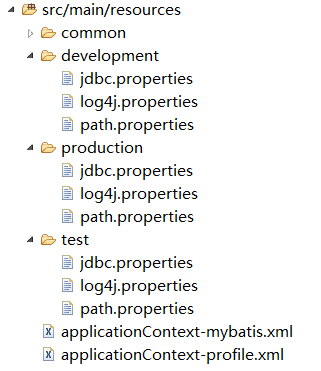软件开发过程一般涉及“开发 -> 测试 -> 部署上线”多个阶段,每个阶段的环境的配置参数会有不同,如数据源,文件路径等。为避免每次切换环境时都要进行参数配置等繁琐的操作,可以通过spring的profile功能来进行配置参数的切换。
以我用到的项目的实际情况为例,首先可以在resources文件夹下分别为每个环境建立单独的文件夹(也可以额外建立一个common文件夹,用于存放公共的参数配置文件),每个文件夹下面存放对应的环境所需的配置文件,就像这样子:

在resources文件夹下建立applicationContext-profile.xml文件,用来定义不同的profile:
<?xml version="1.0" encoding="UTF-8"?> <beans xmlns="http://www.springframework.org/schema/beans" xmlns:c="http://www.springframework.org/schema/c" xmlns:xsi="http://www.w3.org/2001/XMLSchema-instance" xmlns:p="http://www.springframework.org/schema/p" xmlns:jdbc="http://www.springframework.org/schema/jdbc" xmlns:jee="http://www.springframework.org/schema/jee" xmlns:context="http://www.springframework.org/schema/context" xsi:schemaLocation="http://www.springframework.org/schema/beans http://www.springframework.org/schema/beans/spring-beans.xsd http://www.springframework.org/schema/context http://www.springframework.org/schema/context/spring-context.xsd http://www.springframework.org/schema/jdbc http://www.springframework.org/schema/jdbc/spring-jdbc.xsd http://www.springframework.org/schema/jee http://www.springframework.org/schema/jee/spring-jee.xsd"> <description>spring profile配置</description> <!-- 开发环境配置文件 --> <beans profile="development"> <context:property-placeholder location="classpath*:common/*.properties, classpath*:development/*.properties" /> </beans> <!-- 测试环境配置文件 --> <beans profile="test"> <context:property-placeholder location="classpath*:common/*.properties, classpath*:test/*.properties" /> </beans> <!-- 生产环境配置文件 --> <beans profile="production"> <context:property-placeholder location="classpath*:common/*.properties, classpath*:production/*.properties" /> </beans> </beans>
这样就实现了通过profile标记不同的环境,接下来就可以通过设置spring.profiles.default和spring.profiles.active这两个属性来激活和使用对应的配置文件。default为默认,如果没有通过active来指定,那么就默认使用default定义的环境。
这两个属性可以通过多种方法来设置:
- 在web.xml中作为web应用的上下文参数context-param;
- 在web.xml中作为DispatcherServlet的初始化参数;
- 作为JNDI条目;
- 作为环境变量;
- 作为JVM的系统属性;
- 在集成测试类上,使用@ActiveProfiles注解配置。
前两者都可以在web.xml文件中设置:
<?xml version="1.0" encoding="UTF-8"?> <web-app version="3.0" xmlns="http://java.sun.com/xml/ns/javaee" xmlns:xsi="http://www.w3.org/2001/XMLSchema-instance" xsi:schemaLocation="http://java.sun.com/xml/ns/javaee http://java.sun.com/xml/ns/javaee/web-app_3_0.xsd"> <display-name>Archetype Created Web Application</display-name> <context-param> <param-name>contextConfigLocation</param-name> <param-value> classpath*:/applicationContext*.xml </param-value> </context-param> <!-- 在上下文context-param中设置profile.default的默认值 --> <context-param> <param-name>spring.profiles.default</param-name> <param-value>development</param-value> </context-param> <!-- 在上下文context-param中设置profile.active的默认值 --> <!-- 设置active后default失效,web启动时会加载对应的环境信息 --> <context-param> <param-name>spring.profiles.active</param-name> <param-value>development</param-value> </context-param> <servlet> <servlet-name>appServlet</servlet-name> <servlet-class>org.springframework.web.servlet.DispatcherServlet</servlet-class> <!-- 在DispatcherServlet参数中设置profile的默认值,active同理 --> <init-param> <param-name>spring.profiles.default</param-name> <param-value>development</param-value> </init-param> <load-on-startup>1</load-on-startup> </servlet> <servlet-mapping> <servlet-name>appServlet</servlet-name> <url-pattern>/</url-pattern> </servlet-mapping> </web-app>
激活指定的环境,也可以通过JVM参数来设置,可以在tomcat的启动脚本中加入以下JVM参数来激活:
-Dspring.profiles.active="production"
在程序中,也可以通过 @Profile("...") 对某些资源进行注解,这样只有当选择对应的环境时,才会产生对应的bean,如:
/** * 容器配置类 * 用于测试@Profile注解 */ @Configuration @PropertySource(value = {"classpath:/dbconfig.properties"}) public class ProfileBeanConfig implements EmbeddedValueResolverAware { //数据库连接用户名 @Value(value = "${jdbc.username}") private String username; //数据库连接密码 private String password; //开发环境数据源 @Bean(value = "dataSourceDev") @Profile(value = "dev") public DataSource dataSourceDev(@Value("${jdbc.driverClass}") String driverClass) throws PropertyVetoException { ComboPooledDataSource comboPooledDataSource = new ComboPooledDataSource(); comboPooledDataSource.setUser(this.username); comboPooledDataSource.setPassword(this.password); comboPooledDataSource.setDriverClass(driverClass); comboPooledDataSource.setJdbcUrl("jdbc:mysql://localhost:3306/dev"); return comboPooledDataSource; } //测试环境数据源 @Bean(value = "dataSourceTest") @Profile("test") public DataSource dataSourceTest(@Value("${jdbc.driverClass}") String driverClass) throws PropertyVetoException { ComboPooledDataSource comboPooledDataSource = new ComboPooledDataSource(); comboPooledDataSource.setUser(this.username); comboPooledDataSource.setPassword(this.password); comboPooledDataSource.setDriverClass(driverClass); comboPooledDataSource.setJdbcUrl("jdbc:mysql://localhost:3306/test"); return comboPooledDataSource; } //生产环境数据源 @Bean(value = "dataSourceProduction") @Profile("production") public DataSource dataSourceProduction(@Value("${jdbc.driverClass}") String driverClass) throws PropertyVetoException { ComboPooledDataSource comboPooledDataSource = new ComboPooledDataSource(); comboPooledDataSource.setUser(this.username); comboPooledDataSource.setPassword(this.password); comboPooledDataSource.setDriverClass(driverClass); comboPooledDataSource.setJdbcUrl("jdbc:mysql://localhost:3306/production"); return comboPooledDataSource; } //获取字符串解析器 @Override public void setEmbeddedValueResolver(StringValueResolver resolver) { //解析配置文件,然后对数据库连接密码进行赋值 this.password = resolver.resolveStringValue("jdbc.password"); } }
以下是切换数据源示例
//创建匿名容器 AnnotationConfigApplicationContext applicationContext = new AnnotationConfigApplicationContext(); //设置环境,其值为@Profile注解的属性值 applicationContext.getEnvironment().setActiveProfiles("test"); //注册容器类 applicationContext.register(ProfileBeanConfig.class); //刷新容器 applicationContext.refresh();